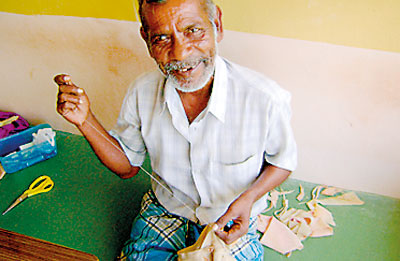Sunday Times 2
Ageing Asia needs mature policies
South Asia’s population is ageing faster than anywhere else in the world, posing challenges to planners and societies, says Nalaka Gunawardene.
Right economic and health policies, as well as changes in mindsets, can help countries turn these challenges into opportunities for human development.
Population ageing happens when older people (typically over 60) account for an increasingly large proportion of the total population. It is the result of declining fertility rates, lower infant mortality and increasing survival at older ages – all triumphs of development.
Developing Asia’s population ageing broadly follows the historical pattern of countries growing older as they become richer. But it is happening at a much greater speed.

Image credit: Mayur Paul/Helpage International
Worldwide, older people’s share of population has risen sharply. In 1950, when the world’s population was 2.5 billion, there were 205 million persons over 60. In 2014, there are 868 million people over 60 – nearly 12 per cent of the global population.
In the eight countries that make up South Asia, the percentage of older people in 2012 ranged from 3.8 in Afghanistan to 12.9 in Sri Lanka. India’s 100 million older people make up 8 per cent of its population. All will see this share increase in the coming decades.
This demographic transition requires completely new approaches to economic planning, health care, retirement policies, living arrangements and inter-generational relations.
The good news: today’s older people are markedly different compared to those even two generations ago. They are healthier and remain active well into their 70s or 80s. This enhances their value to families and society. They are a resource waiting to be harnessed. This was highlighted at a recent conference in Chiang Mai, Thailand, convened by the global charity HelpAge International.
To benefit from this, societies must redesign and realign.
Retirement needs rethinking as people enjoy longer and healthier lives. Philip O’Keefe, the World Bank’s lead economist on social protection and labour, noted how Asian countries’ retirement age has not kept up with rising life expectancy. But rather than embarking on the often contentious revision of retirement age, he suggested, countries could gradually ‘blur the line’ between working and stopping it – as Japan, Korea and Singapore did.
Pension schemes and social protection need more attention. According to the United Nations Economic and Social Commission for Asia and the Pacific (UNESCAP), less than one third of Asia’s older persons receive any kind of pension. This leaves poorer older people highly vulnerable.
The Chiang Mai conference called for a change in how old age is seen in modern societies. The alarmist media narrative, portraying ageing as a ‘demographic time-bomb’ or ‘silver tsunami’, is not accurate. Nor is this fate inevitable. We must perceive and respond to ageing differently -thus avoiding a self-fulfilling prophecy.
The Global AgeWatch Index ranks countries by how well their ageing populations are faring. Compiled by HelpAge International, it measures performance in four areas: income, health, employment and education, and existence of an ‘enabling environment’ (based on factors like physical safety, civic freedom and access to public transport).
Among South Asian countries, Sri Lanka was placed relatively higher (43), while Bangladesh (60), India (69) and Nepal (70) were in the middle. Pakistan (91) and Afghanistan (96) have a long way to go.
Limited resources need not be a barrier to a country providing for its older citizens, for example through a social pension. The Index highlights how Nepal spends five times as much as India on its social pension relative to GDP, when its GDP per capita is half of India’s.
Indeed, the Index stresses the value of social pensions – which are tax-financed and non-contributory – as key to tackling inequality among older people. It resonates with current calls to ensure that ‘no one is left behind’.
(Courtesy scidev.net)

